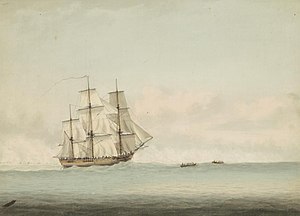
Back HMS Endeavour Afrikaans Endeavour (Schiff) ALS إتش إم إس انديفور Arabic HMB Endeavour Catalan HMS Endeavour Czech Endeavour (Schiff) German Endeavour Esperanto HMB Endeavour Spanish HMS Endeavour Basque اچاماس اندور Persian

| |
| History | |
|---|---|
| Name | Endeavour |
| Operator | Thomas Millner, Royal Navy, J. Mather |
| Builder | Thomas Fishburn, Whitby[2] |
| Launched | June 1764 |
| Acquired | 28 March 1768 as Earl of Pembroke[1] |
| Commissioned | 26 May 1768 |
| Decommissioned | September 1774 |
| Out of service | March 1775, sold |
| Renamed | Lord Sandwich, February 1776 |
| Homeport | Plymouth, United Kingdom |
| Fate | Scuttled, Newport, Rhode Island, 1778 |
| General characteristics [3] | |
| Class and type | Bark |
| Tons burthen | 366 49⁄94 (bm)[4] |
| Length | 97 ft 8 in (29.77 m)[4][a] |
| Beam | 29 ft 2 in (8.89 m)[4] |
| Depth of hold | 11 ft 4 in (3.45 m)[4] |
| Sail plan |
|
| Speed | 7 to 8 knots (13 to 15 km/h) maximum |
| Boats & landing craft carried | yawl, pinnace, longboat, two skiffs |
| Complement | |
| Armament | 10 4-pdrs, 12 swivel guns |
HMS Endeavour[b] was a British Royal Navy research vessel that Lieutenant James Cook commanded to Tahiti, New Zealand and Australia on his first voyage of discovery from 1768 to 1771.
She was launched in 1764 as the collier Earl of Pembroke, with the Navy purchasing her in 1768 for a scientific mission to the Pacific Ocean and to explore the seas for the surmised Terra Australis Incognita or "unknown southern land". Commissioned as His Majesty's Bark Endeavour, she departed Plymouth in August 1768, rounded Cape Horn and reached Tahiti in time to observe the 1769 transit of Venus across the Sun. She then set sail into the largely uncharted ocean to the south, stopping at the islands of Huahine, Bora Bora, and Raiatea west of Tahiti to allow Cook to claim them for Great Britain. In September 1769, she anchored off New Zealand, becoming the first European vessel to reach the islands since Abel Tasman's Heemskerck 127 years earlier.
In April 1770, Endeavour became the first European ship to reach the east coast of Australia, with Cook going ashore at what is now known as Botany Bay. Endeavour then sailed north along the Australian coast. She narrowly avoided disaster after running aground on the Great Barrier Reef, and Cook had to throw her guns overboard to lighten her. Endeavour was beached on the Australian mainland for seven weeks to permit repairs to her hull. Resuming her voyage, she limped into port in Batavia in October 1770, her crew sworn to secrecy about the lands that they had visited. From Batavia Endeavour continued westward, rounded the Cape of Good Hope on 13 March 1771 and reached the English port of Dover on 12 July, having been at sea for nearly three years.
The ship was largely forgotten after her Pacific voyage, spending the next three years hauling troops and cargo to and from the Falkland Islands. She was renamed in 1775 after being sold into private hands, and used to transport timber from the Baltic. Rehired as a British troop transport during the American War of Independence, she was finally scuttled in a blockade of Narragansett Bay, Rhode Island, in 1778. Historical evidence indicates the ship was sunk just north of Goat Island in Newport Harbor, along with four other British transports.[9]
Relics from Endeavour are displayed at maritime museums worldwide, including an anchor and six of her cannon. A replica of Endeavour was launched in 1994 and is berthed alongside the Australian National Maritime Museum in Sydney Harbour. Multiple geographic features are named after the ship, including the Endeavour River and Endeavour Reef, as were three spacecraft. The ship is depicted on the New Zealand fifty-cent coin.
- ^ Knight 1933.
- ^ Hough 1995, p. 55.
- ^ Blainey 2008, p. 17.
- ^ a b c d Winfield 2007, pp. 354–355.
- ^ McLintock 1966.
- ^ Beaglehole 1968, p. 2.
- ^ Cite error: The named reference
ANMM584was invoked but never defined (see the help page). - ^ "Frequently Asked Questions of the Sailing Navy Gallery". www.royalnavalmuseum.org. National Museum of the Royal Navy. Retrieved 18 July 2014.
- ^ "Shipwreck confirmed as Captain Cook's Endeavour after 22-year search". ABC News. 3 February 2022. Retrieved 3 February 2022.
Cite error: There are <ref group=lower-alpha> tags or {{efn}} templates on this page, but the references will not show without a {{reflist|group=lower-alpha}} template or {{notelist}} template (see the help page).
© MMXXIII Rich X Search. We shall prevail. All rights reserved. Rich X Search